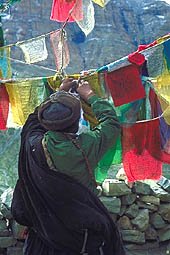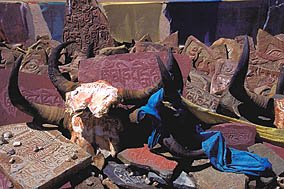
To Mt Kailash

|
Ali (Shiquanhe) was built by the Chinese to administer that vast region of Western Tibet. It is the only shopping centre for miles. The city is dry and dusty, one side distinctly Chinese and the other Tibetan. Many of the Chinese that have settled there, have been sponsored by the Chinese government to start small businesses and a new life. The men in green (Public Security Bureau) were quick to find us, we hadn’t even left our hotel room before they were knocking at our door. There was little fuss and a $US 50 fine enabled us to become legal aliens. After a welcome hot shower at the public baths (the only place in town with hot water on tap) and a two day wait we secured a lift with a convey of four trucks and began a detour to Mount Kailash. With the prestige of being Asia’s most sacred mountain, Mount Kailash (6714m) is an important religious site and pilgrimage destination for both Buddhists and Hindus alike. It is the place of origin of their most venerable gods and the sacred river Ganges.

|
The journey was flatter, but still at high altitudes over a dry and dusty land. There was no road only a well worn truck trail but at least the nights were warmer and we could sleep out under the light of the stars and a full moon without collecting ice. The journey was made light hearted by a disco dancing truck driver and a watermelon feast to celebrate the full moon. Passing a couple of truckloads of Tibetan pilgrims dressed in their finest costume, we wondered if anyone still made the long pilgrimage from Lhasa by foot. After 21/2 days we got our first views of the majestic lone peak of Mt Kailash as we arrived in Darchen, the starting point of the pilgrimage. We met a old wizened Indian Sadhu, a true ascetic, who had walked bare foot over the Himalayas to complete his third circuit of the sacred Kailash. Not being ascetics ourselves, we set off on the 53 km path (khora) that circumambulates the entire mountain armed with tent, sleeping bags, warm clothes and food. Most Tibetan pilgrims complete the circuit in a frenzy, swinging prayer wheels and uttering mantras, taking only one day (12-14hrs). Walking at a more leisurely pace, the khora usually takes a minimum of three days. During their lifetimes, many Tibetan pilgrims attempt more than one round, most doing three. The more devout circle 13 times and the even more pious aim for 108 circuits. One circuit is said to wipe out a lifetime of sins, 108 ensures enlightenment and entry into nirvana.

|
During our four day trek we face all the elements – burning sun, harsh wind, rain and snow. Meeting each challenge of the gods we were passed by the faithful who carried almost nothing. Along the path there are many monuments and nature-formed icons which have been bestowed with potent spirituality as a result of frequent contact with saints and holy men. Six monasteries are scattered around the circuit each with its own mystical history. The two major cemeteries are especially eerie places, littered with offerings of hair, fingernails, teeth, clothes and bones. These are the sacred burial grounds of past enlightened beings and are now a place to meditate and absorb the special powers left behind. They are also used for the ceremonious sky burials, the most common of the five burial types (earth, water, fire, sky and embalming) practised in Tibet. Traditionally the corpse is laid out in the open, carefully skinned and dissected and the bones crushed and mixed with tsampa (barley flour) all to be eaten by flocks of ravens, hawks and vultures.

|
As we’re standing at Drachom Ngagye Durtro cemetery ominous clouds roll over and the wind picks up. Looking around us we see typical offerings and a few circling black ravens. Near to where we are standing the remains of two fingers reveal a recent sky burial sending shivers down our spines. We move on. On the third evening we see the peak of the mighty Mt. Kailash, which since the first night has been covered in cloud. The night brings snow and we wake the next day to see a caravan of yaks and Tibetan pilgrims passing by on the snow dusted trail. Brimming with joy they wave and yell "Tarshee Delay" the traditional Tibetan greeting.

|
The climb ahead to Drolma pass (5636m) is steep and passes a number of spiritually significant sites, which with small rituals, help to cleanse sins and improve prospects for the next life. The crossing of Drolma represents the transition from this life to the next. Here all the pilgrim is reborn and all sins are forgiven by the Goddess of Mercy. This is a place of rejoicing. Yak butter is dabbed on rock surfaces, prayer flags are lifted, offerings are left, prostrations and wishes are made. Here the pilgrims eat their best meal of the journey to ensure bountiful food in times to come. It seems that everyone is ‘on top of the world’ as they feast on dry yak cheese, tsampa mixed with butter and sugar, We share in the festivities watching different groups come and go. You can’t help reflecting on your own life and having a few words with whomever your God may be. Further down the track we meet two women and a nun nursing a pilgrim. No one is sure exactly what is wrong, hypothermia, exhaustion or altitude sickness, but she’s shivering and unable to walk. We brew a hot cup of protein packed chocolate on the portable stove, wrap warm clothes around her and give her half a Diamox tablet in case it’s altitude sickness as she says she has a headache. The almost placebo dose seems to work wonders and with the help of her friends she makes it down the steep slope, to the river and along to a rest stop where the women refuel with yak butter tea and tsampa.
On our final days of the trek we’re accompanied by a beautiful white dog who even spends the night with us. It is said that the dogs that roam the khora are the spirits of old monks and ascetics. Our dog leads us into Darchen and disappears, perhaps to start the circuit again. A little tired and hungry, we arrive back in Darchen and are greeted by some Nepalese pilgrims we met on the circuit. Three of the party of eight didn’t make it around, turning back with signs of altitude sickness.

|